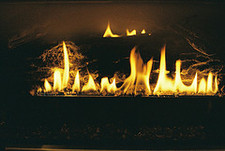
by blogediter | Apr 24, 2019 | Gas Logs
Q: Jason, I have a set of vent free gas logs in my fireplace. The fireplace also has a regular 18″ round chimney flue and a round metal flapper damper. If I understand correctly most vent free gas logs do not have a chimney since they are supposed to vent into the house directly to provide all the heat to the living area.
The damper on this ventless gas log fireplace chimney is worn out and lets in noise and cold air when the fireplace is not being used. Can I install a Chimney Balloon above the damper and close the damper and keep the Chimney Balloon in place even during the time I use this ventless gas log fireplace? – KK
A: Dear KK, We get a lot of questions about using a Chimney Balloon with gas log fireplaces. Especially about ventless gas log fireplaces that have chimneys. Most vent less (or vent free) gas log fireplaces do not have chimneys or flues in the first place. They are often designed to vent directly into the living area. This does allow them to give all of their heat to the living area, but it also allows them to give all of their fumes and moisture to the living area as well. For this reason I am not too keen on vent free gas logs.
To get to your question about the Chimney Balloon and if you can use it above your damper on this vent free gas log. You said your damper is leaking in cold air and noise from the outside and the damper is not in good shape. This means the leak goes both ways on your damper. Cold is coming in and heat certainly going out both during your fireplace use and when the fireplace is dormant. The Chimney Balloon is designed to shrivel and release when heat or fire is introduced to it. This release mechanism triggers at about 180 to 220 degrees. The Chimney Balloon does this because it is designed to plug the chimney flue, and in most cases it is not desirable to have a plugged chimney flue when you have a fire in your fireplace.
So if you light a fire in your ventless fireplace and the Chimney Balloon is installed above your damper (even with the damper closed) the damper itself will heat up and conduct heat through. As you said, the damper is also leaky since it allows cold air down, it will also allow heat up as well. That heat will come in contact with the Chimney Balloon. This will certainly trigger the release of the Chimney Balloon sooner or later (probably sooner). Then you will have a cooked Chimney Balloon. It is still worth it to have the Chimney Balloon in place in your fireplace when you are not using this vent free fireplace since it will eliminate the cold air and noise issue, but you cant leave it in place during use of your fireplace.
I have had many people ask: “what is safe to use above a ventless gas log to plug the flue?” Some people use safing insulation to plug the fireplace flue above a ventless gas log. I realize safing insulation is fire retardant, but safing insulation is not made for this specific purpose so this is a risky venture at best. – Jason
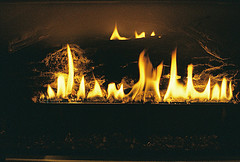
by blogediter | Mar 11, 2019 | Gas Logs
Jason – I converted my masonry fireplace with natural gas and installed an unvented gas log set. Can I install a Chimney Balloon above the damper, keeping the damper closed and ignite my gas logs without incurring any damage to the Chimney Balloon? The gas log set is rated at 39K but. Thanks, CB
Dear CB, If the temperature in the flue gets to about 200 degrees Fahrenheit it will trigger the release mechanism in the Chimney Balloon. Essentially the Chimney Balloon membrane melts and shrinks at the same time and the Chimney Balloon falls out of the Chimney. I’m betting that you will get heat conducting through your damper that will exceed 170 degrees within minutes with this vent free gas log turned on. Unfortunately, the metal from the damper will conduct the heat right through.
On the other hand, it will benefit you to use a Chimney Balloon above the damper when you are not using the fireplace. This is how it is normally used and it will keep your nice warm inside air inside where it belongs and not be floating up past a leaky damper.
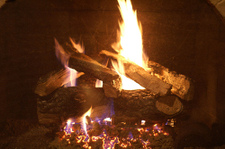
by blogediter | Dec 19, 2018 | Chimney Plugs
Gas log
Q: Jason – I have an old vented gas log that is crumbling and needs to be replaced. What is better to replace it with, a vented gas log or a vent-less gas log?-NW
A: NW- If you go with a vented gas log install you will certainly have to commit yourself to having the chimney damper removed or clipped or disabled in the open position according to current code for vented fireplace install. This means you will have a gaping hole to the outside
all the time. Many gas log owners are surprised to find that their fireplace flue damper has already been disabled when their original gas log was installed. The building fireplace code that states to disable the damper, is often an adequate enough reason for a homeowner not to go with any vented variety gas log.
In the vent-less model, you do get the benefit of retaining all of the heat if you keep the damper closed, but any of the CO, CO2, Nitrogen or moisture that it puts out will enter your living area as well. In the winter when your home is closed up you really want to minimize the extra pollutants you introduce to your already recycled inside air. This is not just with the fireplace, this goes for candles, sprays, paints and other pollutants. You obviously can’t avoid these items all-together, but do you want to introduce new contributors like a vent-free fireplace?
From our conversation on the phone, I am sure you have your heart set on a vented gas log, and you were just looking for brand-name references from me. But please take into account other options like electric fireplace inserts if you are looking for fireplace ambiance, or maybe even a candelabra with candles burned with the damper open as other suitable ambiance option that won’t cost you in heat loss. – Jason
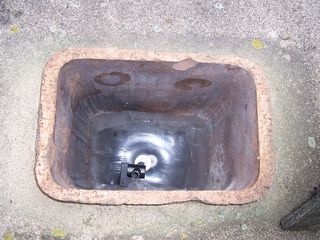
by blogediter | Aug 31, 2018 | Gas Logs
Plug My Vent Free Gas Log Chimney
Q: Jason, I have a set of non-vented gas logs which when not in use lets a horrible downflow of cold air in from outside. I saw an old thread that said the Chimney Balloon will deflate when installing near the damper if it is exposed to heat.
My question is can I close off the top of the chimney chase up on the roof with one of the Chimney Balloons? And would the temperature at that height be cool enough where we could fire the gas logs and still keep the Chimney Balloon intact? Thanks, DV
A: Hi DV, You pose a very good question. We have had many customers install a Chimney Balloon upside down from the top of the chimney when they have installed an electric fireplace insert, or if they have decommissioned their fireplace completely, but I have strong reservations about trying it with a vent free gas log.
My initial reaction is with the vent free gas log burning I am certain that the temperature at the top of the chimney will get to the 200 degrees Fahrenheit and trigger the Chimney Balloon to melt, shrink, and release. The reason for my certainty is that the damper you have is inevitably going to leak heat or convect heat into the chimney and that heat will naturally rise and collect against the Chimney Balloon.
My suggestion is to use the Chimney Balloon conventionally and just install it while the fireplace is not being used. Any amount of time you have the Chimney Balloon installed will be saving you money.
There is one other thing you should be aware of with your vent free gas log. There was a University of IL 3 year study that was done on ventless gas units in homes in Illinois. Here is a link to a blog article about the study and a link to the study results: http://www.chimneyballoonusa.com/blog/2009/08/3-year-univ-of-il-study-results-answer-how-safe-are-ventless-gas-logs.html
Personally, I found this research to be eye-opening and something that ventless gas log users should be aware of. I will let you draw your own conclusion from it, but pay particular attention to the NO2 level results in the study.- Jason
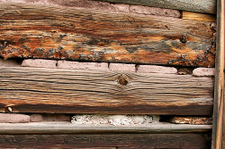
by blogediter | Jun 25, 2018 | Gas Logs
Log wall
Q: Jason, I live in Tennessee, in a restored log home from the very early 1800s. I have a number of ventless logs inside of chimneys (which were originally wood burning.) We use our ventless logs during the winter to heat the rooms we’re in. (The house is 6000 square feet, and keeping the whole thing climate controlled seems wasteful, considering how poor logs are as insulators…) I want to figure out some way to keep more of the heat from the ventless logs in. Is the right thing to get one of your Chimney Balloons, some sort of heat reflector, a blower fan, or to stop being a cheapskate and spend the 700 a month it takes to heat the whole house if we simply do things “the normal way” with the central H/AC. – ER
A: Dear ER, Thank you for your interest in the Chimney Balloon. In order to answer your question well I think i need to clarify with you that you do in fact have vent free gas logs. If you have vent-free gas logs you would have no chimney at all in the fireplace. The vent free variety of fireplace is usually just a firebox in the wall with a heat disapator on the top of the fire box. If this is in fact what you have, then you have no need for a Chimney Balloon because you have no chimney. If you have a vented gas log then you do have a chimney in your fireplace and it is likely that the damper has been clipped open or is otherwise disabled due to current code regarding gas logs. In this case a Chimney Balloon will help you quite a bit. When a vented gas fireplace is not in use, its open damper will suck the heat right out of the room due to the air stack effect in your home, especially in historacle log construction like your home. As far as heating your home goes. Right now it sounds like you are practicing zone heating. This can be very effective way of cost savings in a home your size (6000 square feet). I hate to say this…but $700 per month is actually a resonable amount to pay in the winter months to heat this size of area with a traditional HVAC system. If there are not many of you living in your home you may find zone heating is the way to go. I am for it as long as it is done safely and makes your home as usable as it can be for your needs. I would encourage you to have an energy audit of your home (if you havent already) as a trained professional in insulation would be able to direct you to even greater savings, Jason
Q: Thanks for the reply. Here is where it gets weird. In the 6 fireplaces in my home, there *used* to be standard issue wood fires. Then they were replaced by vented gas logs in the 70s. In the very late 90s early 2ks, they replaced all of the vented logs with *ventless* logs. So I have 6 fireplaces with ventless logs in my house 🙂 Actual fireplaces, with chimneys. So, given *that*, what do you think is the right “plan A”? 🙂 Thanks! – ER
A: OK, well that clears things up a bit. Since you do have chimneys over these “ventless” gas logs then you can use a Chimney Balloon to plug these fireplace chimneys. The key is that you have to remove the Chimney Balloon from the chimney before you light that particular fireplace. This is particularly important to note if you are used to just firing up your gas logs without opening a damper. A Chimney Balloon is deigned to burst if you light a fire under it, and it doesnt matter if it is a vented or vent free fire. You have a unique situation here, but with a home that is 200 years old I bet you have a lot of unique situations with your home. Im sure it has a lot of character and has had many owners over it life and each owner has made interesting changes im sure. If I can be of further assistance please let me know – Jason




